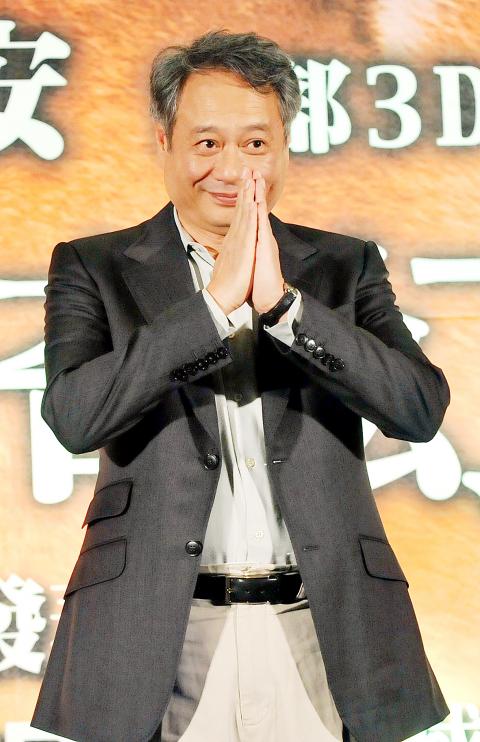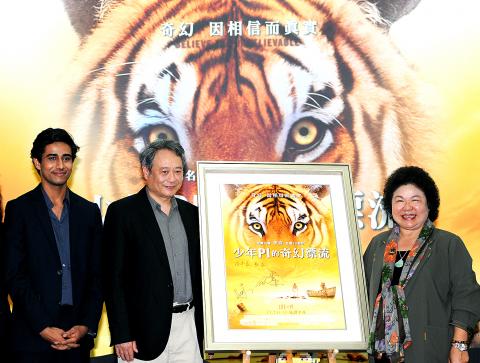Ang Lee’s (李安) Life of Pi hit Taiwan theaters Nov. 21. Adapted from Yann Martel’s international bestseller of the same name, the movie is an adventure tale of a boy who miraculously survives months at sea in the company of a Bengal tiger.
Lee, whose repertoire of films includes Crouching Tiger, Hidden Dragon (臥虎藏龍), Brokeback Mountain, Lust, Caution (色,戒) and Taking Woodstock, returned to Taiwan on Nov. 9 to commemorate the building of the VFX Center, a new high-end filmmaking studio, in Kaohsiung’s Pier 2 district that did much of the film’s eye-catching visuals.
Life of Pi gives life

Photo: Reuters
Prashant Buyyala, managing director of Rhythm & Hues (R&H), the company operating the center which also has facilities in India, Malaysia, Canada and the US, said that Lee’s vision and the movie were the primary reasons why they set it up in Taiwan.
“R&H will train new talent and provide opportunities for the next generation of Taiwanese artists to work on major Hollywood films without having to leave home.” This translates to future creation of 200 jobs for digital artists in Taiwan, he added.
Life of Pi took four years to produce, with 70 percent of it filmed in Taiwan, and involved construction in a former Taichung airport of a 1.7-million-gallon water tank complete with wave machine to simulate being lost in the middle of the Pacific Ocean.

Photo: AFP
The film’s production employed over 14,000 people in several countries. Locals and expats who vied nationwide to be extras in the film were paid about NT$3,000 per day.
“I wondered why we didn’t have such a company in Taiwan. If Malaysia and India can do this, why not Taiwan? So I helped (R&H) set one up,” said the Oscar-winning Lee.
In a forum with Kaohsiung Mayor Chen Chu (陳菊), the film’s now 18-year-old lead star Suraj Sharma and R&H executives, Ang said he chose the special effects company because of its track record.

Photo: Taipei Times
“They’re the best at visual effects,” he said, adding, “I only work with the best companies.”
Setting up the film studio in Taiwan, he said, “is also good stimulus to drive us to be [more] innovative. It’s an issue that needs examination and reflection. The filmmaking industry needs a comprehensive supply chain. That is what is lacking in Taiwan. We need to elevate the infrastructure in Taiwan and equip young people with knowledge,” Lee said.
Initially, Lee had to convince 20th Century Fox executives to support his vision for the film. Fox eventually sign off on the massive US$120 million production costs — a large portion spent on its special effects, using not only the best in CGI (computer generated imagery) but also 3D technology.
Animal madness
R&H collected over 400 hours of stock footage — including thousands of still photos — of animals in Taiwan, France and at an animal trainer’s ranch in Los Angeles. Animators then pored over this material to study every detail regarding “the texture of the animals,” so as to achieve the highest degree of realism.
Although a number of shots in the film use real animals, Berger specified that state-of-the-art animation technologies such as the Cameron Pace System helped capture much of the tiger’s movement, “down to the 10,000 hairs of the tiger … every splay of a paw.”
When asked about the most difficult moment making Life of Pi, Berger said, “Every day is equally different as the day preceding it. It’s not like you’re a painter, where you decide to paint something and do it. It’s like building a skyscraper, involving thousands of people.”
Prashant Buyyala, R&H’s managing director, said that a Taiwan production center was “economically viable,” and “perfect, for now.” In the past, R&H considered opening studios in Europe and China.
The Kaohsiung Connection
“We saw Taiwan as a great destination, and we’ve become big fans of this country,” said Buyyala, “not just because of Ang but because of relationships we’ve built with people here, with students and government officials,” he said, noting Kaohsiung’s beauty, quality of life and low cost of living as particular advantages for its employees.
“Plus the Taiwan government wanted to get into co-production,” and as a global high-tech center Taiwan had both the technology and political will to support development in its creative industries, he said.
Kaohsiung Mayor Chen Chu was thrilled with the new cooperation.
“Kaohsiung used to be a highly polluted city, but now it deserves a chance” to be a player in Taiwan’s budding film industry, she said.
Berger said he found Lee “amazingly gracious. He had a strong vision of what he wanted to see and he stuck to it. He’s a very passionate director and really listens to the people around him for their opinions.”
Erika Burton, R&H’s co-president, added that Lee is inclusive and generous with his time and with his commitments.
“He always takes the time to thank the people who work with him,” Burton said.
Excited about the studio’s construction Lee said, “This is only the beginning. Starting from today, I hope we can see some great work done in Taiwan. I really want to see more cultural collaboration and exchanges.”
Life of Pi is currently playing at cinemas throughout the nation.

As we live longer, our risk of cognitive impairment is increasing. How can we delay the onset of symptoms? Do we have to give up every indulgence or can small changes make a difference? We asked neurologists for tips on how to keep our brains healthy for life. TAKE CARE OF YOUR HEALTH “All of the sensible things that apply to bodily health apply to brain health,” says Suzanne O’Sullivan, a consultant in neurology at the National Hospital for Neurology and Neurosurgery in London, and the author of The Age of Diagnosis. “When you’re 20, you can get away with absolute

When the South Vietnamese capital of Saigon fell to the North Vietnamese forces 50 years ago this week, it prompted a mass exodus of some 2 million people — hundreds of thousands fleeing perilously on small boats across open water to escape the communist regime. Many ultimately settled in Southern California’s Orange County in an area now known as “Little Saigon,” not far from Marine Corps Base Camp Pendleton, where the first refugees were airlifted upon reaching the US. The diaspora now also has significant populations in Virginia, Texas and Washington state, as well as in countries including France and Australia.

On April 17, Chinese Nationalist Party (KMT) Chairman Eric Chu (朱立倫) launched a bold campaign to revive and revitalize the KMT base by calling for an impromptu rally at the Taipei prosecutor’s offices to protest recent arrests of KMT recall campaigners over allegations of forgery and fraud involving signatures of dead voters. The protest had no time to apply for permits and was illegal, but that played into the sense of opposition grievance at alleged weaponization of the judiciary by the Democratic Progressive Party (DPP) to “annihilate” the opposition parties. Blamed for faltering recall campaigns and faced with a KMT chair

May 5 to May 11 What started out as friction between Taiwanese students at Taichung First High School and a Japanese head cook escalated dramatically over the first two weeks of May 1927. It began on April 30 when the cook’s wife knew that lotus starch used in that night’s dinner had rat feces in it, but failed to inform staff until the meal was already prepared. The students believed that her silence was intentional, and filed a complaint. The school’s Japanese administrators sided with the cook’s family, dismissing the students as troublemakers and clamping down on their freedoms — with